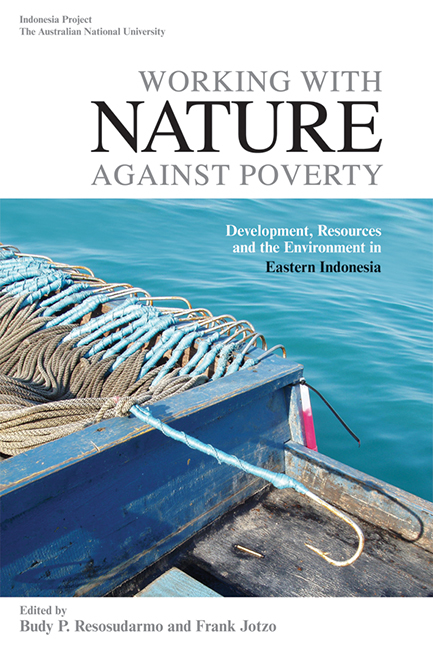Book contents
- Frontmatter
- Foreword
- Contents
- Figures and Maps
- Tables
- Contributors
- Acknowledgments
- Glossary
- Map
- 1 Development, Resources and Environment in Eastern Indonesia
- PART I ECONOMIC DEVELOPMENT AND POVERTY ALLEVIATION
- PART II NATURAL RESOURCES AND THE ENVIRONMENT
- 6 Balancing Biodiversity Conservation and Development in Eastern Indonesia
- 7 Between a Rock and a Hard Place: Corporate Strategy at the Freeport Mine in Papua, 2001–2006
- 8 Illegal Fishing in the Arafura Sea
- 9 Searching for a Livelihood: The Dilemma of Small-boat Fishermen in Eastern Indonesia
- 10 Forest Management and Conflict: The Case of the Rendani Protection Forest in Papua
- 11 Climate Change and Development in Eastern Indonesia
- PART III CONFLICT, LOCAL DEVELOPMENT AND HEALTH
- Index
10 - Forest Management and Conflict: The Case of the Rendani Protection Forest in Papua
from PART II - NATURAL RESOURCES AND THE ENVIRONMENT
Published online by Cambridge University Press: 21 October 2015
- Frontmatter
- Foreword
- Contents
- Figures and Maps
- Tables
- Contributors
- Acknowledgments
- Glossary
- Map
- 1 Development, Resources and Environment in Eastern Indonesia
- PART I ECONOMIC DEVELOPMENT AND POVERTY ALLEVIATION
- PART II NATURAL RESOURCES AND THE ENVIRONMENT
- 6 Balancing Biodiversity Conservation and Development in Eastern Indonesia
- 7 Between a Rock and a Hard Place: Corporate Strategy at the Freeport Mine in Papua, 2001–2006
- 8 Illegal Fishing in the Arafura Sea
- 9 Searching for a Livelihood: The Dilemma of Small-boat Fishermen in Eastern Indonesia
- 10 Forest Management and Conflict: The Case of the Rendani Protection Forest in Papua
- 11 Climate Change and Development in Eastern Indonesia
- PART III CONFLICT, LOCAL DEVELOPMENT AND HEALTH
- Index
Summary
INTRODUCTION
Papua's biologically diverse forests serve a multiplicity of roles and functions for its people. Historically, they have provided Papuans with household needs for food and shelter, a resource base for gardening and products to trade, while also fulfilling a fundamentally important cultural role. Although products from Papua's forests have been exploited commercially and exported regionally for at least a thousand years, it is only in the past 25 years that forest degradation and loss associated with large-scale commercial timber harvesting, an expansion of agricultural cash crops and the growth of population centres have begun to threaten the survival of the forests and the communities that depend on them. This chapter presents a case study of a particular forest and community, exemplifying issues of forest management and conflict in Papua more widely.
Indonesia's New Order government asserted state ownership over the country's forests in 1967, denying customary (adat) ownership and rights. It began to exploit the forests by issuing large-scale timber harvesting concessions (HPHs). Other pressures on Indonesia's forests have included those associated with the expansion of forest and palm oil plantations and agricultural crops, and with transmigration. In Papua, as elsewhere in Indonesia, forests were zoned into those intended for conservation and protection, those to be retained for wood production and those to be converted to plantations or agriculture. The respective proportions of Papua's 33 million hectares of forests in these three broad categories are 46 per cent (conservation), 31 per cent (wood production) and 23 per cent (conversion).
With minor exceptions, during the Dutch colonial period and for some time afterwards, Papua's forests remained under indigenous forest management. The first HPH over Papuan forests was issued in 1984. By 2000, there were 54 HPHs covering a total area of 13 million hectares, a further 10 industrial forest plantation concessions (HTIs) covering 1.6 million hectares and many small-scale concessions.
- Type
- Chapter
- Information
- Working with Nature against PovertyDevelopment, Resources and the Environment in Eastern Indonesia, pp. 226 - 247Publisher: ISEAS–Yusof Ishak InstitutePrint publication year: 2009



